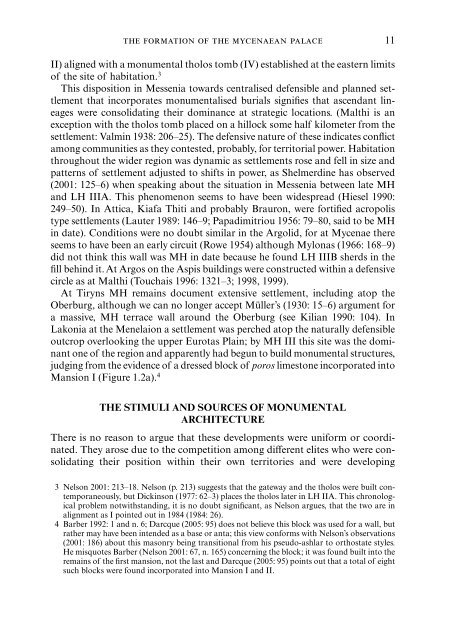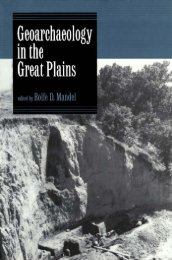- Page 2 and 3: EDINBURGH LEVENTIS STUDIES 3
- Page 4 and 5: EDINBURGH LEVENTIS STUDIES 3 ANCIEN
- Page 6 and 7: CONTENTS Contributors and Editors v
- Page 8 and 9: 23 Some remarks on the semantics of
- Page 10 and 11: contributors and editors ix (thesis
- Page 12 and 13: contributors and editors xi of Dr I
- Page 14 and 15: contributors and editors xiii Aegea
- Page 16 and 17: ABBREVIATIONS 1. Contributed Works
- Page 18 and 19: abbreviations xvii Greek Renaissanc
- Page 20 and 21: abbreviations xix Nichoria in South
- Page 22 and 23: abbreviations xxi DMic II Aura Jorr
- Page 24 and 25: JRGZM Jahrbuch des Römisch-Germani
- Page 26 and 27: INTRODUCTION Sigrid Deger-Jalkotzy
- Page 28: introduction 3 Fortunately, this to
- Page 32 and 33: 1 THE FORMATION OF THE MYCENAEAN PA
- Page 34 and 35: the formation of the mycenaean pala
- Page 38 and 39: the formation of the mycenaean pala
- Page 40 and 41: the formation of the mycenaean pala
- Page 42 and 43: the formation of the mycenaean pala
- Page 44 and 45: the formation of the mycenaean pala
- Page 46 and 47: the formation of the mycenaean pala
- Page 48 and 49: the formation of the mycenaean pala
- Page 50 and 51: the formation of the mycenaean pala
- Page 52 and 53: the formation of the mycenaean pala
- Page 54 and 55: the formation of the mycenaean pala
- Page 56 and 57: (a) (b) Charred door in place Recon
- Page 58 and 59: the formation of the mycenaean pala
- Page 60 and 61: the formation of the mycenaean pala
- Page 62 and 63: the formation of the mycenaean pala
- Page 64 and 65: the formation of the mycenaean pala
- Page 66 and 67: the formation of the mycenaean pala
- Page 68 and 69: the formation of the mycenaean pala
- Page 70 and 71: the formation of the mycenaean pala
- Page 72 and 73: the formation of the mycenaean pala
- Page 74 and 75: the formation of the mycenaean pala
- Page 76 and 77: the formation of the mycenaean pala
- Page 78 and 79: 2 WANAKS AND RELATED POWER TERMS IN
- Page 80 and 81: proposes that the prehellenic cultu
- Page 82 and 83: WANAKS and related power terms 57 C
- Page 84 and 85: WANAKS and related power terms 59 t
- Page 86 and 87:
WANAKS and related power terms 61 L
- Page 88 and 89:
WANAKS and related power terms 63 a
- Page 90 and 91:
WANAKS and related power terms 65 s
- Page 92 and 93:
WANAKS and related power terms 67 T
- Page 94 and 95:
WANAKS and related power terms 69 m
- Page 96:
WANAKS and related power terms 71 P
- Page 99 and 100:
74 cynthia w. shelmerdine treatment
- Page 101 and 102:
76 cynthia w. shelmerdine contribut
- Page 103 and 104:
78 cynthia w. shelmerdine were impo
- Page 105 and 106:
80 cynthia w. shelmerdine experts o
- Page 107 and 108:
82 cynthia w. shelmerdine receives
- Page 109 and 110:
84 cynthia w. shelmerdine elite ind
- Page 111 and 112:
86 cynthia w. shelmerdine Killen, J
- Page 113 and 114:
88 john t. killen probability, the
- Page 115 and 116:
90 john t. killen more significant
- Page 117 and 118:
92 john t. killen make up these gro
- Page 119 and 120:
94 john t. killen the Mycenaean dat
- Page 121 and 122:
96 john t. killen (ditch-repairing,
- Page 123 and 124:
98 john t. killen but are collected
- Page 126 and 127:
5 j/Anax AND basileu/ß IN THE HOME
- Page 128 and 129:
j /Anax and basileu/ß in the homer
- Page 130 and 131:
j /Anax and basileu/ß in the homer
- Page 132 and 133:
j /Anax and basileu/ß in the homer
- Page 134:
j /Anax and basileu/ß in the homer
- Page 138:
Part II CONTINUITY - DISCONTINUITY
- Page 141 and 142:
116 oliver dickinson We have no rea
- Page 143 and 144:
118 oliver dickinson like Tiryns, A
- Page 145 and 146:
120 oliver dickinson types of artef
- Page 147 and 148:
122 oliver dickinson maintained dir
- Page 149 and 150:
124 joseph maran In order to evalua
- Page 151 and 152:
126 joseph maran in the LH IIIC Low
- Page 153 and 154:
128 joseph maran decorated with fre
- Page 155 and 156:
130 joseph maran quite well documen
- Page 157 and 158:
132 joseph maran the only archaeolo
- Page 159 and 160:
134 joseph maran exact position of
- Page 161 and 162:
136 joseph maran (a) Figure 8.3a Un
- Page 163 and 164:
138 joseph maran coils of gold wire
- Page 165 and 166:
140 joseph maran comparison for thi
- Page 167 and 168:
142 joseph maran cultural memory of
- Page 169 and 170:
144 joseph maran who competed again
- Page 171 and 172:
146 joseph maran Deger-Jalkotzy, S.
- Page 173 and 174:
148 joseph maran post-palatial pers
- Page 175 and 176:
150 joseph maran Waldbaum, J. C. (1
- Page 177 and 178:
152 sigrid deger-jalkotzy Syro-Pale
- Page 179 and 180:
154 sigrid deger-jalkotzy 1. WARRIO
- Page 181 and 182:
156 sigrid deger-jalkotzy on his cu
- Page 183 and 184:
158 sigrid deger-jalkotzy The first
- Page 185 and 186:
160 sigrid deger-jalkotzy Nikoleïk
- Page 187 and 188:
162 sigrid deger-jalkotzy Grotta on
- Page 189 and 190:
164 sigrid deger-jalkotzy two bow f
- Page 191 and 192:
Table 9.1 LH IIIC warrior tombs wit
- Page 193 and 194:
168 sigrid deger-jalkotzy Volos reg
- Page 195 and 196:
Table 9.3 Ascertainable find contex
- Page 197 and 198:
172 sigrid deger-jalkotzy the indiv
- Page 199 and 200:
174 sigrid deger-jalkotzy However,
- Page 201 and 202:
176 sigrid deger-jalkotzy Moreover
- Page 203 and 204:
178 sigrid deger-jalkotzy Maran, J.
- Page 206 and 207:
10 THE ARCHAEOLOGY OF BASILEIS Alex
- Page 208 and 209:
the archaeology of BASILEIS 183 lea
- Page 210 and 211:
the archaeology of BASILEIS 185 pro
- Page 212 and 213:
(b) the archaeology of BASILEIS 187
- Page 214 and 215:
(a) Figure 10.2 Plan (a) and recons
- Page 216 and 217:
Burial 1 Burial 2 the archaeology o
- Page 218 and 219:
the archaeology of BASILEIS 193 lat
- Page 220 and 221:
the archaeology of BASILEIS 195 72)
- Page 222 and 223:
(a) the archaeology of BASILEIS 197
- Page 224 and 225:
the archaeology of BASILEIS 199 of
- Page 226 and 227:
the archaeology of BASILEIS 201 Fig
- Page 228 and 229:
Figure 10.8 Oropos, plan of the Ear
- Page 230 and 231:
the archaeology of BASILEIS 205 Fig
- Page 232 and 233:
the archaeology of BASILEIS 207 Bla
- Page 234 and 235:
the archaeology of BASILEIS 209 Kle
- Page 236:
the archaeology of BASILEIS 211 Bro
- Page 239 and 240:
214 maria kayafa which made the cir
- Page 241 and 242:
216 maria kayafa Table 11.1 (contin
- Page 243 and 244:
218 maria kayafa exceeding the ‘n
- Page 245 and 246:
220 maria kayafa Absolute number 14
- Page 247 and 248:
222 maria kayafa Table 11.3 Present
- Page 249 and 250:
224 maria kayafa THASOS Overall thi
- Page 251 and 252:
226 maria kayafa content ranging fr
- Page 253 and 254:
228 maria kayafa Absolute number et
- Page 255 and 256:
230 maria kayafa Catling, H. W. (19
- Page 258 and 259:
12 ETHNE IN THE PELOPONNESE AND CEN
- Page 260 and 261:
ETHNE in the peloponnese and centra
- Page 262 and 263:
ETHNE in the peloponnese and centra
- Page 264 and 265:
ETHNE in the peloponnese and centra
- Page 266 and 267:
ETHNE in the peloponnese and centra
- Page 268 and 269:
ETHNE in the peloponnese and centra
- Page 270 and 271:
ETHNE in the peloponnese and centra
- Page 272 and 273:
ETHNE in the peloponnese and centra
- Page 274 and 275:
ETHNE in the peloponnese and centra
- Page 276 and 277:
ETHNE in the peloponnese and centra
- Page 278 and 279:
ETHNE in the peloponnese and centra
- Page 280:
Part III INTERNATIONAL AND INTER-RE
- Page 283 and 284:
258 beate wagner-hasel in greater d
- Page 285 and 286:
260 beate wagner-hasel which for us
- Page 287 and 288:
262 beate wagner-hasel of assets. P
- Page 289 and 290:
264 beate wagner-hasel service, tha
- Page 291 and 292:
266 beate wagner-hasel prosperous f
- Page 293 and 294:
268 beate wagner-hasel Hattenhauer,
- Page 296 and 297:
14 BASILEIS AT SEA: ELITES AND EXTE
- Page 298 and 299:
BASILEIS at sea 273 late general st
- Page 300 and 301:
(a) (b) Land over 600 m. a.s.l. Lan
- Page 302 and 303:
BASILEIS at sea 277 in east central
- Page 304 and 305:
(e) (c) (a) (f) BASILEIS at sea 279
- Page 306 and 307:
BASILEIS at sea 281 accommodated on
- Page 308 and 309:
BASILEIS at sea 283 (a) (b) (c) (d)
- Page 310 and 311:
BASILEIS at sea 285 continuity in t
- Page 312 and 313:
BASILEIS at sea 287 imported goods
- Page 314 and 315:
BASILEIS at sea 289 conspicuously l
- Page 316 and 317:
BASILEIS at sea 291 This could expl
- Page 318 and 319:
BASILEIS at sea 293 Cherry, J. et a
- Page 320 and 321:
BASILEIS at sea 295 Second Internat
- Page 322:
BASILEIS at sea 297 Voutsaki, S. (1
- Page 325 and 326:
300 david ridgway I prefer to apply
- Page 327 and 328:
302 david ridgway relationship with
- Page 329 and 330:
304 david ridgway preference for th
- Page 331 and 332:
306 david ridgway and Vagnetti 1991
- Page 333 and 334:
308 david ridgway as we were all br
- Page 335 and 336:
310 david ridgway Gallin, L. J. and
- Page 337 and 338:
312 david ridgway Peroni, R. and Tr
- Page 340 and 341:
16 FROM THE MYCENAEAN QA-SI-RE-U TO
- Page 342 and 343:
the BASILEUS in the kingdoms of cyp
- Page 344 and 345:
the BASILEUS in the kingdoms of cyp
- Page 346 and 347:
the BASILEUS in the kingdoms of cyp
- Page 348 and 349:
the BASILEUS in the kingdoms of cyp
- Page 350 and 351:
the BASILEUS in the kingdoms of cyp
- Page 352 and 353:
the BASILEUS in the kingdoms of cyp
- Page 354 and 355:
the BASILEUS in the kingdoms of cyp
- Page 356 and 357:
the BASILEUS in the kingdoms of cyp
- Page 358 and 359:
the BASILEUS in the kingdoms of cyp
- Page 360:
the BASILEUS in the kingdoms of cyp
- Page 363 and 364:
338 nicholaos chr. stampolidis and
- Page 365 and 366:
340 nicholaos chr. stampolidis and
- Page 367 and 368:
342 nicholaos chr. stampolidis and
- Page 369 and 370:
344 nicholaos chr. stampolidis and
- Page 371 and 372:
346 nicholaos chr. stampolidis and
- Page 373 and 374:
348 nicholaos chr. stampolidis and
- Page 375 and 376:
350 nicholaos chr. stampolidis and
- Page 377 and 378:
352 nicholaos chr. stampolidis and
- Page 379 and 380:
354 nicholaos chr. stampolidis and
- Page 381 and 382:
356 nicholaos chr. stampolidis and
- Page 383 and 384:
358 nicholaos chr. stampolidis and
- Page 385 and 386:
360 nicholaos chr. stampolidis and
- Page 388 and 389:
18 FROM KINGS TO DEMIGODS: EPIC HER
- Page 390 and 391:
from kings to demigods 365 It is th
- Page 392 and 393:
from kings to demigods 367 traditio
- Page 394 and 395:
from kings to demigods 369 denote e
- Page 396 and 397:
from kings to demigods 371 culprits
- Page 398 and 399:
from kings to demigods 373 generati
- Page 400 and 401:
from kings to demigods 375 that par
- Page 402 and 403:
from kings to demigods 377 some of
- Page 404:
from kings to demigods 379 Malkin,
- Page 407 and 408:
382 carla antonaccio but rather to
- Page 409 and 410:
384 carla antonaccio THE THRICE HER
- Page 411 and 412:
386 carla antonaccio A special topi
- Page 413 and 414:
388 carla antonaccio with bronze wo
- Page 415 and 416:
390 carla antonaccio order here. Th
- Page 417 and 418:
392 carla antonaccio While the Toum
- Page 419 and 420:
394 carla antonaccio the house was
- Page 422 and 423:
20 CULT ACTIVITY ON CRETE IN THE EA
- Page 424 and 425:
cult activity on crete in the early
- Page 426 and 427:
cult activity on crete in the early
- Page 428 and 429:
cult activity on crete in the early
- Page 430 and 431:
cult activity on crete in the early
- Page 432 and 433:
cult activity on crete in the early
- Page 434 and 435:
cult activity on crete in the early
- Page 436 and 437:
cult activity on crete in the early
- Page 438 and 439:
cult activity on crete in the early
- Page 440:
Part V THE HOMERIC EPICS AND HEROIC
- Page 443 and 444:
418 michael meier-brügger 1. GENER
- Page 445 and 446:
420 michael meier-brügger style sh
- Page 447 and 448:
422 michael meier-brügger of affai
- Page 449 and 450:
424 michael meier-brügger initial
- Page 451 and 452:
426 michael meier-brügger Tichy, E
- Page 453 and 454:
428 edzard visser tragedies can be
- Page 455 and 456:
430 edzard visser other. Rather, th
- Page 457 and 458:
432 edzard visser It took some time
- Page 459 and 460:
434 edzard visser that can contain
- Page 461 and 462:
436 edzard visser seems to be likel
- Page 464 and 465:
23 SOME REMARKS ON THE SEMANTICS OF
- Page 466 and 467:
some remarks on the semantics of an
- Page 468 and 469:
some remarks on the semantics of an
- Page 470 and 471:
some remarks on the semantics of an
- Page 472:
some remarks on the semantics of an
- Page 475 and 476:
450 kurt a. raaflaub intention of a
- Page 477 and 478:
452 kurt a. raaflaub resisting the
- Page 479 and 480:
454 kurt a. raaflaub the story, but
- Page 481 and 482:
456 kurt a. raaflaub elements in th
- Page 483 and 484:
458 kurt a. raaflaub of fighting an
- Page 485 and 486:
460 kurt a. raaflaub Benzi, M. (200
- Page 487 and 488:
462 kurt a. raaflaub Rocher, L. (19
- Page 490 and 491:
25 THE PALACE OF IOLKOS AND ITS END
- Page 492 and 493:
the palace of iolkos and its end 46
- Page 494 and 495:
Megaron B LH IIIA2 LH IIIB Alterati
- Page 496 and 497:
the palace of iolkos and its end 47
- Page 498 and 499:
the palace of iolkos and its end 47
- Page 500 and 501:
the palace of iolkos and its end 47
- Page 502 and 503:
the palace of iolkos and its end 47
- Page 504 and 505:
the palace of iolkos and its end 47
- Page 506:
the palace of iolkos and its end 48
- Page 509 and 510:
484 fanouria dakoronia Greece, for
- Page 511 and 512:
Figure 26.2 The graves in Gouras pl
- Page 513 and 514:
Table 26.2 Gouras Plot Gouras lot B
- Page 515 and 516:
Table 26.2 (continued) Gouras lot B
- Page 517 and 518:
Table 26.2 (continued) Gouras lot B
- Page 519 and 520:
494 fanouria dakoronia other burial
- Page 521 and 522:
496 fanouria dakoronia Figure 26.5
- Page 523 and 524:
498 fanouria dakoronia iron, were d
- Page 525 and 526:
500 fanouria dakoronia Figure 26.9
- Page 527 and 528:
502 fanouria dakoronia Figure 26.12
- Page 529 and 530:
504 fanouria dakoronia References A
- Page 531 and 532:
506 irene s. lemos ATHENS TO THE EN
- Page 533 and 534:
508 irene s. lemos Thus in these th
- Page 535 and 536:
510 irene s. lemos houses just abov
- Page 537 and 538:
512 irene s. lemos Ilissos River wh
- Page 539 and 540:
514 irene s. lemos and Papadopoulos
- Page 541 and 542:
516 irene s. lemos this period. Apa
- Page 543 and 544:
518 irene s. lemos areas and worksh
- Page 545 and 546:
Figure 27.2 Lefkandi: Xeropolis and
- Page 547 and 548:
522 irene s. lemos Figure 27.3 The
- Page 549 and 550:
524 irene s. lemos the north slope
- Page 551 and 552:
526 irene s. lemos cemetery precede
- Page 553 and 554:
528 irene s. lemos Hurwit, J. M. (1
- Page 555 and 556:
530 irene s. lemos Bronze Age and E
- Page 557 and 558:
532 alkestis papadimitriou one-stor
- Page 559 and 560:
534 alkestis papadimitriou French n
- Page 561 and 562:
536 alkestis papadimitriou (a) (b)
- Page 563 and 564:
538 alkestis papadimitriou (a) Figu
- Page 565 and 566:
540 alkestis papadimitriou Figure 2
- Page 567 and 568:
542 alkestis papadimitriou scarab a
- Page 569 and 570:
544 alkestis papadimitriou The hoar
- Page 571 and 572:
546 alkestis papadimitriou (Papadim
- Page 574 and 575:
29 THE WORLD OF TELEMACHUS: WESTERN
- Page 576 and 577:
the world of telemachus: western gr
- Page 578 and 579:
the world of telemachus: western gr
- Page 580 and 581:
the world of telemachus: western gr
- Page 582 and 583:
the world of telemachus: western gr
- Page 584 and 585:
the world of telemachus: western gr
- Page 586 and 587:
the world of telemachus: western gr
- Page 588 and 589:
the world of telemachus: western gr
- Page 590 and 591:
the world of telemachus: western gr
- Page 592 and 593:
the world of telemachus: western gr
- Page 594 and 595:
the world of telemachus: western gr
- Page 596 and 597:
the world of telemachus: western gr
- Page 598 and 599:
the world of telemachus: western gr
- Page 600 and 601:
the world of telemachus: western gr
- Page 602 and 603:
the world of telemachus: western gr
- Page 604 and 605:
the world of telemachus: western gr
- Page 606 and 607:
30 KNOSSOS IN EARLY GREEK TIMES J.
- Page 608 and 609:
knossos in early greek times 583 Fi
- Page 610 and 611:
KNOSSOS c.1100-600 BC Tombs Settlem
- Page 612 and 613:
knossos in early greek times 587 Fi
- Page 614 and 615:
knossos in early greek times 589 de
- Page 616 and 617:
knossos in early greek times 591 Fi
- Page 618 and 619:
knossos in early greek times 593 Fi
- Page 620 and 621:
knossos in early greek times 595 Co
- Page 622 and 623:
31 PRAISOS: POLITICAL EVOLUTION AND
- Page 624 and 625:
praisos: political evolution and et
- Page 626 and 627:
praisos: political evolution and et
- Page 628 and 629:
edrock praisos: political evolution
- Page 630 and 631:
praisos: political evolution and et
- Page 632 and 633:
praisos: political evolution and et
- Page 634 and 635:
praisos: political evolution and et
- Page 636 and 637:
praisos: political evolution and et
- Page 638 and 639:
praisos: political evolution and et
- Page 640 and 641:
praisos: political evolution and et
- Page 642:
praisos: political evolution and et
- Page 645 and 646:
620 saro wallace against which to d
- Page 647 and 648:
622 saro wallace SETTLEMENT AND ECO
- Page 649 and 650:
624 saro wallace is not possible to
- Page 651 and 652:
Site of which size is not possible
- Page 653 and 654:
628 saro wallace almost certainly b
- Page 655 and 656:
630 saro wallace as the dense settl
- Page 657 and 658:
632 saro wallace transformed, and a
- Page 659 and 660:
634 saro wallace Figure 32.7 Fortif
- Page 661 and 662:
636 saro wallace Figure 32.9 Palaeo
- Page 663 and 664:
638 saro wallace the various compon
- Page 665 and 666:
640 saro wallace century when value
- Page 667 and 668:
Figure 32.10 Map of PG-Archaic site
- Page 669 and 670:
644 saro wallace foothills as Drero
- Page 671 and 672:
646 saro wallace Cyclades (Boardman
- Page 673 and 674:
648 saro wallace seem important for
- Page 675 and 676:
650 saro wallace Bennet, J. (1999a)
- Page 677 and 678:
652 saro wallace Davaras, C. and So
- Page 679 and 680:
654 saro wallace Hallager, E. and H
- Page 681 and 682:
656 saro wallace Kipp, R. and Schor
- Page 683 and 684:
658 saro wallace Nowicki, K. (1999)
- Page 685 and 686:
660 saro wallace Rutkowski, B. (198
- Page 687 and 688:
662 saro wallace Tsipopoulou, M. (1
- Page 689 and 690:
664 saro wallace Xanthoudidis, S. A
- Page 691 and 692:
666 vassos karageorghis (Karageorgh
- Page 693 and 694:
668 vassos karageorghis funerals. N
- Page 695 and 696:
670 vassos karageorghis During the
- Page 697 and 698:
672 vassos karageorghis parts of th
- Page 699 and 700:
674 vassos karageorghis Buchholz, H
- Page 701 and 702:
Note: Page numbers in italic denote
- Page 703 and 704:
678 index Athens (continued) Mousei
- Page 705 and 706:
680 index Crete (continued) citadel
- Page 707 and 708:
682 index elites (continued) archit
- Page 709 and 710:
684 index Homer (continued) Iliad c
- Page 711 and 712:
686 index koine, 37, 195, 282, 289,
- Page 713 and 714:
688 index mistress, 446 mlk, 317, 3
- Page 715 and 716:
690 index Phaistos (continued) Lili
- Page 717 and 718:
692 index Salamis, Cyprus (continue
- Page 719 and 720:
694 index thrones, 37, 142 ivory, 3






